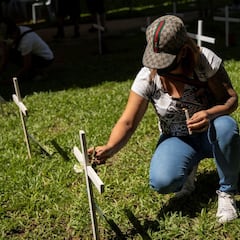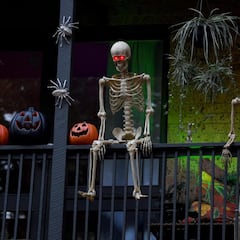Why do people paint their face for Dia de los Muertos?
The Mexican celebration of the Day of the Dead is often confused with Halloween in the United States, but the iconic face-painting tradition is instantly recognisable.


The annual celebration of Day of the Dead, or Dia de los Muertos, began several thousand years ago with the Aztec, Toltec and Nahua peoples. These pre-Hispanic cultures considered mourning the dead disrespectful, perceiving death as simply another part of the natural journey of life.
The dead were considered eternal members of the community and so rather than mark their passing they would be kept alive in spirit. The tradition goes that during Dia de los Muertos the spirits of deceased relatives and friends temporarily return to Earth.
Día de los Muertos is here!
— Pixar (@Pixar) November 1, 2021
Join us for a look into how Coco pays tribute to the traditions of the holiday. pic.twitter.com/8LY8Ult3Mf
The celebration takes place on 1 and 2 November every year, and the bone-white skeletal face painting has become one of the most iconic emblems of the tradition. Here’s the history of the Dia de los Muertos face paint…
When was face painting incorporated into Dia de los Muertos celebrations?
At Dia de los Muertos celebrations in much of Latin America, la calavera de azucar, or a ‘sugar skull’, is a common sight. The face masks are traditionally moulded from sugar and decorated with glitter, feathers and much more.
This tradition has merged into the practice of face painting to replicate the calaveras, commonly incorporating both traditional Aztec influences and European symbolism. The shared Catholic faith of much of Latin America and Hispanic cultures brings with it a religious influence which is often displayed in the face painting.
One of the more recognized pieces of Dia de los Muertos (Day of the Dead) celebrations are the calavera de azúcar (sugar skulls) that decorate ceremonial ofrenda (altars) and tombstones during the festivities. Here's how to make your own ... https://t.co/VGRuvijAg0
— Berkshire Eagle (@BerkshireEagle) November 1, 2021
The image of a calavera most commonly associated with Dia de los Muertos now is that of La Calavera Catrina, a skeletal portrait of a high society lady. The image is thought to be taken from a 1910 sketch by Mexican artist Jose Guadalupe Posada and was originally intended to be a satire of the elitist upper classes of the early 20th century; the message being that we are all equal in death.
Is it ok to copy calavera face painting on Dia de los Muertos?
As with many elements of traditional culture, there is the danger that blindly repurposing the ‘look’ of la calavera de azucar could cause offense. For many people in Latin America the holiday, and the associated pageantry, is an opportunity to honour those who have died but is considered more of a celebration than a day of mourning.
Related stories

What is All Saints Day and why do we celebrate it?
Mexican-American makeup artist Judith Bautista, also known as Kahlovera, has no problem with providing the Catrina makeup for clients on Halloween and told Allure that she enjoys the chance to educate people on elements of Mexican culture.
She says: “Most people just want to look like cool skulls for the night, and I take the opportunity to share a bit of my culture with them. I explain that it’s a symbol of Dia de los Muertos, a completely different holiday.”
